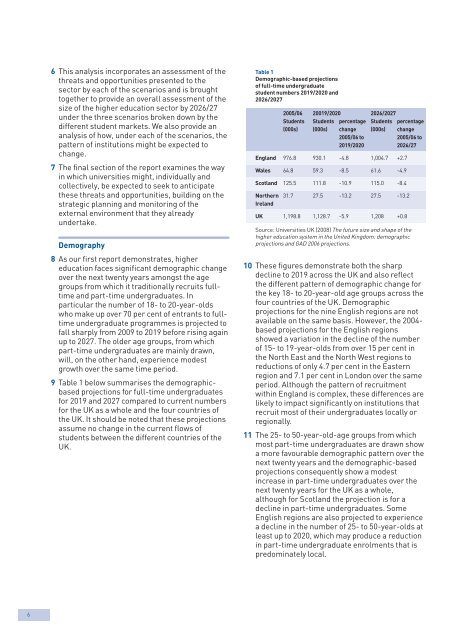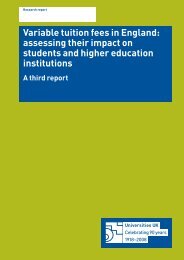The future size and shape of HE - Universities UK
The future size and shape of HE - Universities UK
The future size and shape of HE - Universities UK
- No tags were found...
Create successful ePaper yourself
Turn your PDF publications into a flip-book with our unique Google optimized e-Paper software.
6 This analysis incorporates an assessment <strong>of</strong> thethreats <strong>and</strong> opportunities presented to thesector by each <strong>of</strong> the scenarios <strong>and</strong> is broughttogether to provide an overall assessment <strong>of</strong> the<strong>size</strong> <strong>of</strong> the higher education sector by 2026/27under the three scenarios broken down by thedifferent student markets. We also provide ananalysis <strong>of</strong> how, under each <strong>of</strong> the scenarios, thepattern <strong>of</strong> institutions might be expected tochange.7 <strong>The</strong> final section <strong>of</strong> the report examines the wayin which universities might, individually <strong>and</strong>collectively, be expected to seek to anticipatethese threats <strong>and</strong> opportunities, building on thestrategic planning <strong>and</strong> monitoring <strong>of</strong> theexternal environment that they alreadyundertake.Demography8 As our first report demonstrates, highereducation faces significant demographic changeover the next twenty years amongst the agegroups from which it traditionally recruits fulltime<strong>and</strong> part-time undergraduates. Inparticular the number <strong>of</strong> 18- to 20-year-oldswho make up over 70 per cent <strong>of</strong> entrants to fulltimeundergraduate programmes is projected t<strong>of</strong>all sharply from 2009 to 2019 before rising againup to 2027. <strong>The</strong> older age groups, from whichpart-time undergraduates are mainly drawn,will, on the other h<strong>and</strong>, experience modestgrowth over the same time period.9 Table 1 below summarises the demographicbasedprojections for full-time undergraduatesfor 2019 <strong>and</strong> 2027 compared to current numbersfor the <strong>UK</strong> as a whole <strong>and</strong> the four countries <strong>of</strong>the <strong>UK</strong>. It should be noted that these projectionsassume no change in the current flows <strong>of</strong>students between the different countries <strong>of</strong> the<strong>UK</strong>.Table 1Demographic-based projections<strong>of</strong> full-time undergraduatestudent numbers 2019/2020 <strong>and</strong>2026/20272005/06 20019/2020 2026/2027Students Students percentage Students percentage(000s) (000s) change (000s) change2005/06 to 2005/06 to2019/2020 2026/27Engl<strong>and</strong> 976.8 930.1 -4.8 1,004.7 +2.7Wales 64.8 59.3 -8.5 61.6 -4.9Scotl<strong>and</strong> 125.5 111.8 -10.9 115.0 -8.4Northern 31.7 27.5 -13.2 27.5 -13.2Irel<strong>and</strong><strong>UK</strong> 1,198.8 1,128.7 -5.9 1,208 +0.8Source: <strong>Universities</strong> <strong>UK</strong> (2008) <strong>The</strong> <strong>future</strong> <strong>size</strong> <strong>and</strong> <strong>shape</strong> <strong>of</strong> thehigher education system in the United Kingdom: demographicprojections <strong>and</strong> GAD 2006 projections.10 <strong>The</strong>se figures demonstrate both the sharpdecline to 2019 across the <strong>UK</strong> <strong>and</strong> also reflectthe different pattern <strong>of</strong> demographic change forthe key 18- to 20-year-old age groups across thefour countries <strong>of</strong> the <strong>UK</strong>. Demographicprojections for the nine English regions are notavailable on the same basis. However, the 2004-based projections for the English regionsshowed a variation in the decline <strong>of</strong> the number<strong>of</strong> 15- to 19-year-olds from over 15 per cent inthe North East <strong>and</strong> the North West regions toreductions <strong>of</strong> only 4.7 per cent in the Easternregion <strong>and</strong> 7.1 per cent in London over the sameperiod. Although the pattern <strong>of</strong> recruitmentwithin Engl<strong>and</strong> is complex, these differences arelikely to impact significantly on institutions thatrecruit most <strong>of</strong> their undergraduates locally orregionally.11 <strong>The</strong> 25- to 50-year-old-age groups from whichmost part-time undergraduates are drawn showa more favourable demographic pattern over thenext twenty years <strong>and</strong> the demographic-basedprojections consequently show a modestincrease in part-time undergraduates over thenext twenty years for the <strong>UK</strong> as a whole,although for Scotl<strong>and</strong> the projection is for adecline in part-time undergraduates. SomeEnglish regions are also projected to experiencea decline in the number <strong>of</strong> 25- to 50-year-olds atleast up to 2020, which may produce a reductionin part-time undergraduate enrolments that ispredominately local.6
















